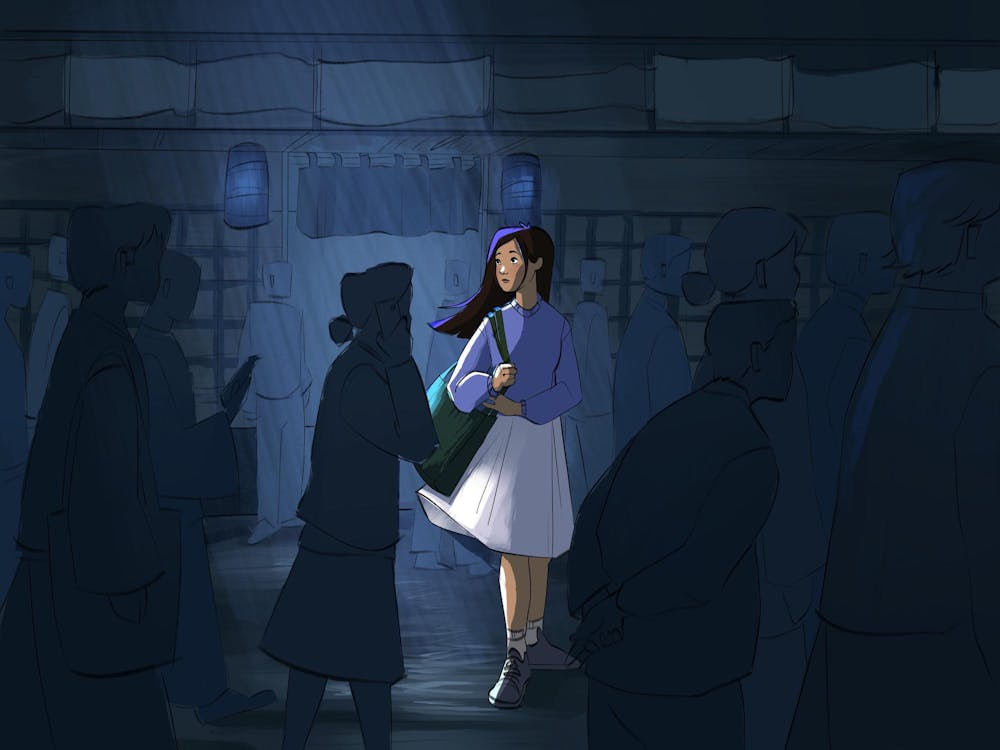Ukiyo-e (“Pictures of the Floating World”), a genre of Japanese art focusing on the portrayal of ukiyo (“The Floating World”), flourished from the 17th through the 19th century. During the Edo period (1603-1868), the economy in Japan boomed and the country was unified under the strict control of the Tokugawa Shogunate. This brought prosperity to an emerging merchant class and allowed the arts and culture to flourish as people had more time for leisure and entertainment.
Hiroshige, Utagawa. One Hundred Famous Views of Edo: Night View of Saruwaka-machi, 1856, woodblock print.
The bustling city, a prevalent theme in Hinohara Kenji’s An Introduction to Ukiyo-e, details life in the newly urbanized city of Edo (modern-day Tokyo), where great masters produced works to commemorate the 18th century’s largest city and its new social patterns. A major sub-theme of the bustling city was famous places in Edo with artworks featuring bridges, key points in the city’s transportation network, popular temples and shrines, and the Yoshiwara officially-licensed pleasure quarter. Another subcategory of entertainment was kabuki, a popular form of theater and one of the greatest delights of the commoners, or heimin. Additionally, sumo emerged as a popular spectator sport.
Despite all these activities and the mass migration from rural communities to Edo, alienation and isolation remained pervasive, exacerbated by Japan being closed off to the rest of the world. Loneliness became more prominent in the city. Great masters like Hiroshige managed to portray this paradoxical theme of urban alienation during the prime years of ukiyo-e.
Hiroshige’s woodblock print Night View of Saruwaka-machi, part of the series One Hundred Famous Views of Edo, illustrates the new theater district of Saruwaka-machi, or Saruwaka Street, named after Saruwaka Kanzaburo, the founder of Edo kabuki theater in the Nakamura Theater over 200 years earlier.
In this scene, teahouses line the east side of the street on the left of the print, as well as puppet theaters further in the background. On the right side are the three main kabuki theaters licensed by the government, arranged in order of seniority. The theaters are identified through the boxed turrets called yagura projected above the eaves of the buildings, indicating government approval. Typically during the theater season, the fronts of the buildings are covered with signs and banners, and the streets are packed with people as they file in and out. However, this scene features a much quieter and detached autumn atmosphere.
Typical scenes of the city show the chaos of a rush hour, simultaneously implying a network of deeply-connected social relations. However, the city’s dynamic in Hiroshige’s print seems much more distant and subdued in a mysterious and dangerous atmosphere.
Upon closer inspection into the people populating this scene, the figures are mostly turned away from each other with downcast expressions and little interaction. Even those walking together or in close proximity, like the two women in the center, are turned in opposite directions. This could portray ideas of timidness and modesty, but it could also reflect the sad and lonely atmosphere sensed through the print. It reveals urban isolation—disconnection despite the dense population. The only visible interaction, between waitresses and their guests from the veranda, implies that relationships in the city are limited to business, lacking deeper connections. The lack of facial details on most of the figures reflects a sense of anonymity that creates more lonely souls lost in the sea of the urban fabric.
This print shows a serene night-view landscape. However, the most prominent features of it are the full moon that rises high in the deep autumn sky and the array of shadows cast by the figures. The moon, a subject for depicting seasonal beauty and evoking home, acts in concert with the shadows to add a more eerie effect that suggests the coldness of being alone in the city. The relative darkness of the kabuki theaters paired with the shadows give the print a hauntingly quiet impression in juxtaposition with the typical bustling atmosphere of Saruwaka Street. The shadows, rarely used in ukiyo-e, create a haunting atmosphere and suggest the influence of Western art on Japan, particularly through the use of perspective and depth. However, for both Western viewers accustomed to seeing shadows in art and for Edo viewers to whom shadows are a curiosity, this print still has the similar effect of creating an otherworldly, almost mystical atmosphere.
This print, created in 1856, also reflects the social-historical context of Japan during the final years of its isolation. After the Shimabara Rebellion in 1637, Japan remained closed to the West for over 200 years, fostering a period of peace and cultural flourishing. Although Japan's isolation officially ended in 1853 with Commodore Matthew Perry's arrival, significant societal changes didn't occur until the Meiji Restoration in 1868. Despite the print’s crowded space, the disconnected figures symbolize Japan's detachment from the rapidly globalizing world. After two centuries of insularity, this disconnection within the population is captured in the subdued and detached crowd scene Hiroshige portrays in one of the most striking pieces in his series.





